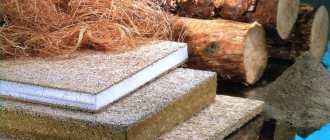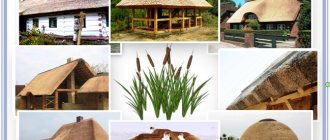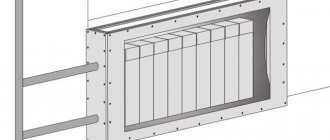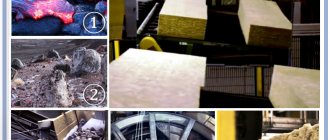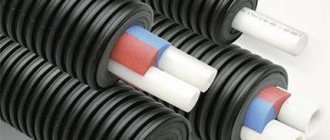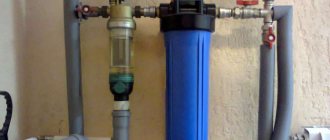Perhaps you need:
Dowel for insulation with metal nail 10x160 mm
More details
Dowel for insulation with plastic nail 10x110 mm
More details
Screw dowel for thermal insulation 18x110 mm
More details
The density of polystyrene foam for insulation ranges from 15 to 35 kg/m³. The value of this parameter for basalt wool is 30-220 kg/m³. With the same dimensions, the weight of a basalt slab exceeds the weight of a polystyrene slab by 2-6 times. At the same time, the thermal conductivity coefficients of both materials are almost the same - 0.035-0.039 W/m·ºK for expanded polystyrene, 0.032-0.048 W/m·ºK for basalt wool.
Such characteristics lead to the conclusion that the fastening of basalt wool slabs (mats) should be significantly more powerful compared to a similar scheme for expanded polystyrene.
Both materials are fixed to the walls in a double way - with glue and dowels at the same time. The glue itself provides a fairly strong and reliable connection, and inside buildings this fastening is often limited. However, outside the house, slabs and glue are exposed to atmospheric influences in the form of alternating and ultra-low temperatures, sudden changes in humidity, and high wind loads that increase with the height of the walls. Therefore, external fastening of insulating boards is carried out with glue and dowels at the same time.
Purpose and advantages of disc fastening
Dowels of a special shape, which are used to install thermal insulation, are called mushrooms or umbrellas in construction. They provide a secure fit even to fragile materials.
With their help, the heat insulator can be attached to various materials:
- concrete;
- stone;
- brick.
Advantages of disc mounting:
- Thanks to the wide cap of the mushroom, a reliable fit to any building insulation is ensured.
- The umbrella, thanks to its long leg, can withstand significant loads. In the center there is a special hole in the cap into which a dowel is inserted.
- On the inside, the surface of the cap is rough for greater adhesion to the insulation.
- Dowels have anti-corrosion properties.
- The plastic from which the dowel is made is inexpensive and reliable.
- The fungal umbrella is a bendable element. It cannot damage the sealing product.
- For reliability, the dowel inside the structure expands in all directions, which leads to strengthening of the fastener structure.
Benefits of fungal fixatives
The widespread use of this option for fastening insulation is due to the following advantages:
- The wide cap ensures reliable fixation of any insulation. The inside of the cap is rough, which also further helps secure the material to the wall.
- The product implies the presence of an expansion washer, which can increase the contact area between the fungus umbrella and the insulating plate from 60 to 100 mm.
- The fastener has a long leg with good load-bearing capacity; it is also reliable due to spacers of three sections.
- Modern plastic dowels are a modified version of wooden plugs and do not have all the disadvantages that wood products have. In particular, plastic does not rot, does not suffer from mold, temperature changes, and this artificial material is cheaper.
- Reliability of fastening structures in the wall is ensured by screwing in a wedge - it pushes the walls of the anchor in all directions. This ensures the fixation of the dowel in the wall.
Classification of fungi for insulation
The needs of the construction industry require diversity in the selection of elements of this type; they can be divided into three categories:
- Fasteners with a polymer nail. When making polymer dowels for insulation, polypropylene, polyamide or nylon is used. Among the main advantages, one can note the low cost, but for the same reason, such a dowel-fungus has weak strength characteristics. It can be used for attaching insulating materials to dense concrete and brick surfaces, but this is only relevant for lightweight insulation materials. Such a fungus for insulation costs about three rubles per piece.
- With a metal nail. This insulation fungus will be much stronger than the previous option. Among the disadvantages, there is a tendency to corrosion, and subsequently, when installed on painted or bleached facades, leaving stains and smudges on the surface.
- With thermal head and metal nail. This fastening element, which has a thermal head, is the main alternative to the previous option. This design is based on the location inside a steel nail, but the head of the nail is covered with a material that has low thermal conductivity characteristics. In most cases, impact-resistant polyamide is used for this, which has a thermal conductivity parameter of 0.027 W/mK, which is not inferior to the characteristics of most materials used for thermal insulation. The cost is determined within six rubles per piece, depending on the manufacturer and factory design features.
Subtleties and nuances of installing thermal insulation
The basic methods for installing thermal insulation for various materials, such as polystyrene foam, penoplex or expanded polystyrene, are identical. All work comes down to a general algorithm, which has several stages:
- Preparation of the surface on which the material will be installed.
- Installation of sheet thermal insulation on an adhesive solution.
- Fastening the panels with fasteners.
- Refinement of panel joints.
- Installation of waterproofing film.
- Covering the insulated surface with decorative materials.
All work must begin with preparing the working surface, removing old paint, wallpaper or plaster, as well as eliminating wall imperfections. Next, the selected material for insulating the room is placed on a specialized solution, which should not contain toluene and acetone. The gluing mixture must be distributed evenly over the entire area of the element being installed. For additional fixation and to prevent the sheets from moving, the first level from the ceiling is secured to a metal profile. After the specified period for the adhesive solution to set, you can begin installing fastening mushrooms . When drilling holes for them, the diameter of the drill is used, which corresponds to the diameter of the fungus stem. The depth of the hole should exceed its length by ten millimeters so that any debris left after drilling does not interfere with the installation of the fasteners.
Construction standards, codes and regulations
If you pay attention to the current legislation in the construction industry, it establishes standards and requirements for the installation of thermal insulation:
- When installing thermal insulation indoors or on the facades of residential one-story buildings outside, per square meter of insulation surface, it is necessary to place 4 elements for fastening in the corners and one in the center.
- At the corners of the walls you will need to additionally secure it with 6 fasteners.
- Provided that the height of the facade is from 8 to 20 meters, 7 fasteners will be required at the edges and one in the center.
- During installation work at a height of over 20 meters, the rules require one square meter of insulated surface to be attached to 9 elements.
The best option is to strengthen fungi at the joints of foam panels or similar material, since this method optimizes the number of holes in the insulation, which will not therefore affect the overall effectiveness of such measures.
If the fastening element needs to be fixed on a metal surface, for example, on corrugated sheeting, then a self-tapping screw is attached to the dowel leg and, together with the insulation, is pressed against the wall, after which the self-tapping screw is screwed into the metal. The depth of screw tightening must be at least 15 millimeters. Next, the joints of the insulating panels are additionally glued with aluminum reinforcing tape, and the corner joints between the walls, ceiling or floor are sealed with polyurethane foam.
Calculation of the required number of fasteners
For high-quality and durable installation of insulation, you need to use fasteners made in accordance with GOST, but also not forgetting to calculate the required number of such parts. The following formula will help for this:
D = T + K + I + Z, where:
- T - Thickness of the installed insulation.
- K - Thickness of the adhesive layer used to fix the panels
- I - The depth of screwing the self-tapping screw into the wall is at least 45 millimeters.
- Z - Possible inclination of the wall relative to the vertical, this parameter is optional.
The length of the dowel anchor for use on brick or concrete walls must be at least 60 millimeters. And if the brick or foam concrete block is hollow, then in this case it is at least 100 millimeters.
How to firmly attach insulation to any wall
There are 3 main methods for attaching to the walls of a building.
I – sheathing. They create a frame base for ventilated cladding. To do this, choose galvanized metal profiles that are resistant to corrosion and temperature changes.
II – glue. Bonding thermal insulation material has subtleties. First, you need to choose a suitable composition that meets all the requirements. The second is moisture resistance. Further, insulation is rarely simply “set” on glue. Additionally, umbrella dowels are used.
There are 2 types of glue:
- dry mixture;
- glue-foam.
The first type is released in bags. It is diluted according to the instructions on the package. Adhesive foam is produced in cylinders. It does not need to be diluted with water or stirred. Application is carried out using a construction gun.
To fix the thermal insulation, it is necessary to carry out preparatory work. The surface must be cleaned of dust and leveled by applying a layer of plaster.
III – use of dowels. This is the main method for firmly fixing thermal insulation. Dowels are used for both additional and primary fixation.
Each method has its own nuances and features. Before choosing a fixation method, you need to assess the wall surface, as well as compare the factors affecting the materials (temperature, humidity, frost resistance).
Mineral or stone wool
To lay mineral wool, create a sheathing of wooden beams.
The distance between the slats should be less than the size of the wool. In this case, the cotton wool will adhere to the base and hold on.
If the thermal insulation is purchased in slabs (it is stiffer), then the slats are filled in a cellular manner.
The wool in the slabs can be glued or dowels can be used. But, the lathing is mandatory.
When using roll insulation, the slats are filled horizontally or vertically.
For lathing, slats are used in height greater than the thickness of the wool. This creates an air gap between the insulation and the finishing coating. This will increase the thermal insulation of the wall.
Penoplex
Penoplex is often used for insulating private houses and apartments at height. To fix it, glue and dowels are used.
To glue polystyrene foam, a flat surface coated with a primer is required. A support strip is stuffed at the bottom, and glue is applied to the foam sheets. After applying the sheet, you need to hold the material for a while so that the adhesive composition sets.
After the glue has set, holes are made in the sheet for dowels. They will create strength.
Polyurethane foam
This is a porous gas-filled polymer based on polyurethane components.
It has a number of distinctive properties, low thermal conductivity. Therefore, it began to be often used in cold regions. Water and sudden changes in temperature do not affect it. Polyurethane foam is produced as foam. Apply to the surface in 2 ways:
- spraying using equipment;
- pouring - special equipment is used for this and voids must be equipped.
The insulation warranty period is up to 50 years.
Video description
What is the best way to glue polystyrene?
Before directly applying the glue, the surface must be treated with antifungal and antiseptic drugs. It is important to choose the right composition, since subsequently access to the junction of materials will be very difficult.
The cheapest option is dry polystyrene foam adhesive, which is made from cement. For use, this product is diluted with liquid. The result is a reliable and durable compound for attaching foam to virtually any type of material.
Also recently, solutions based on polymer cement have become increasingly widespread. They are universal in use and are well suited for gluing insulation to any type of base. To work with facades, you can use products that contain various mineral fillers. Many companies produce products to increase the protective properties of polystyrene foam. After applying glue to the front surface, the material becomes resistant to various environmental factors. In addition to the advantages, such substances also have disadvantages - a long polymerization time, which is about 3 days.
There are also aerosol mixtures containing polyurethane. They can be used as glue or to fill gaps and seams between sheets. These are universal substances that behave equally well both indoors and outdoors. They can be applied to facades, roofs and walls of houses, flooring and other wooden surfaces. In all these cases, the products set quickly and hold the material securely for a long time. And although the prices for such mixtures are relatively high, they are justified by the convenience of applying the glue.
Expanded polystyrene sheets usually begin to fix within 2 hours after gluing the surface. For better stability, the material is secured with anchor bolts for facades.
The main advantages of polyurethane products are: fire resistance, good tolerance to changes in humidity and temperature, environmental friendliness and safety for health. Modern production technologies make it possible to obtain high-quality and easy-to-use compositions. When choosing an adhesive, it is important to consider its chemical reactions with the material. To prevent the destruction of polystyrene foam, you need to purchase products that do not contain acetone or gasoline.
Sometimes sheets of expanded polystyrene need to be glued together. For these purposes, use any wet or dry glue that does not contain solvents. When choosing products, a specific task is taken into account, and then the most suitable product is selected to solve it.
Mounting methods
The choice of fixation method depends on several factors. One of them is the base of the surface: concrete, brick, wood or aerated block.
- The glue is used in a dry composition, which requires preliminary preparation: a mixing container, a construction mixer, spatulas. For outdoor use, certain brands are used that meet all the requirements: frost resistance, moisture, temperature changes, maximum heating.
- Liquid glue in cans is applied using a construction gun. It must also have features: percentage of adhesion, attitude to moisture, service life.
- Dowel umbrellas. There are 3 types: plastic, with a metal pin, with a metal nail and a thermal head. Mostly polymer products or those with a thermal head are used.
- Lathing. They are created extremely rarely due to the properties of the tree. Attitude to moisture, temperature changes. Sometimes the sheathing is made from metal profiles. They are galvanized - this is an advantage, since water does not affect them, as does the temperature.
- Insulating plasters are also used. They are applied in 3 layers on a reinforced mesh (facade).
Dowels to a concrete wall
Dowels are used to glue thermal insulation to concrete. There are 2 parameters by which you need to choose dowels:
- The base is hollow and porous. Based on the concrete base, the load-bearing capacity of the fasteners is calculated.
- Fastening type. Plastic fasteners are not designed for heavy loads.
The dowel is firmly attached to the concrete thanks to the antennae located along the rod. They straighten out in the concrete cavity after screwing in the nail (core). There are also dowels, the core of which is not screwed in, but driven in.
To fix the insulation on a concrete base, it is necessary to carry out preparatory work:
- Clean the surface from old coating - lime, chalk, paint. If there is plaster, it needs to be examined.
- If there are protrusions on the surface, remove them with a power tool. The cracks are filled, reinforced, and plastered.
If the cracks are not repaired, the wall may crumble. There is no point in insulation.
- The surface with mold is dried, cleaned and treated with special products.
- After the work is done, the surface is coated with a primer.
The preparatory process is over.
Now, at the bottom you need to fix a wooden auxiliary strip or a galvanized profile. It will hold the insulation and prevent it from “sliding” down.
The profile must be selected based on the dimensions and weight of the thermal insulation being installed.
Fungi to a brick wall
Installing tile insulation on a brick surface is similar to working on a concrete base. The algorithm of actions is as follows:
- Surface preparation. Checking it for evenness.
- Surface treatment with primer.
- Insulation boards - polystyrene foam, penoplex, expanded polystyrene - are coated with an adhesive solution. Either use a notched trowel and apply glue evenly over the entire surface, or dot application - place dots of solution in the corners and in the center.
- A holder bar is fixed at the bottom of the wall. Install insulation boards.
- After the glue has set, each slab is additionally secured with dowels in the corners and in the center.
- All joints of the slabs are covered with the same solution.
- The last step is covering the surface. Decorative plaster or finishing materials.
Other mounting methods
Roll insulation – mineral wool, a often used material in insulating wooden buildings. A frame is needed to attach it. Warming is carried out as follows:
- Fix the vapor barrier film.
- Install a control strip at the bottom of the wall.
- Along the width (slightly smaller) of the insulation, fill horizontal or vertical wooden slats, which will be higher than the thickness of the insulation.
- Cotton wool is placed in the resulting niches.
- A windproof membrane layer is created on top.
How to install thermal insulation using mushroom dowels
Before you start laying the insulation, you need to calculate the required number of fasteners and their length, based on the thickness of the heat insulator and the insertion of the core by 5 cm into the material of the insulated structure.
Calculation of the length of dowels when attaching insulation to a brick wall
Calculation of the number and length of dowels
The number of fasteners is determined depending on the selected dowel arrangement.
Installing fungi at joints allows you to reduce the number of holes in the insulation
In the first option, it is assumed to use up to 6 products per square meter of insulation. In this case, 4 nails are attached to the corners of the sheet or mat, retreating from the edge by 5-7 cm, the rest are placed evenly in the center.
According to the second option, dowels are installed at the convergence point of several thermal insulation slabs. In this case, one umbrella holds the edges of four mineral wool mats or foam sheets at once. One fastening element is mounted in the center of the insulation. This option will be the most economical if the size of the umbrella allows.
More fasteners will have to be installed at the corners of buildings if the facade is insulated, and at heights, since there is a large wind load there.
It is recommended to use 7 dowels per 1 m2 of insulated area if the height of the building exceeds 8 meters, and 9 if the structure has a height of 20 meters or more. At the same time, it is necessary to increase the number of fungi in the corner areas of the facade.
Step-by-step insulation technology using fasteners in the form of fungi
Before you begin to attach the thermal insulation with fungi, it is necessary to lay a vapor barrier material, which, in addition to its direct function, can act as an additional fastening of mineral wool products or foam boards.
Installation of foil vapor barrier using fungi
The entire installation process consists of several simple operations:
- The surface is marked for drilling holes for the cores at a step distance of 0.8 m horizontally and 0.3 m vertically.
- After this, holes Ø 1 cm are made in the wall and insulation, the depth of which exceeds the length of the leg by 0.5 - 1 cm. The diameter of the drill must correspond to the thickness of the leg.
- The plastic sleeve is inserted manually, without using a hammer, into the hole made. Next, the core is inserted into the sleeve and driven into the base surface until it stops. The central part of the umbrella is closed with a special protective cover.
When using expansion washers, the latter are installed on the plastic sleeve before installing the core.
Installing the starting bar
Before laying the insulation, a starting strip is installed at the bottom of the wall, which will support the thermal insulation so that it does not slide down under its own weight.
If the insulation is installed with glue, the installation of fungi is carried out after the adhesive solution has completely dried. The joints between individual insulation elements are sealed with polyurethane foam or foil tape if penoplex, polystyrene foam and other similar materials are being installed.
Fastening requirements
Insulation anchors are subject to high stress, function in alkaline environments and are exposed to extreme temperatures. This means they must meet several criteria.
- Be resistant to destruction. Both the umbrella itself and the nail must be of very high strength. The nail must be made of galvanized steel so that its material does not react and begin to deteriorate. This is especially important when the material under the “wet facade” is attached with fungus. With this approach, the fungus is covered with a layer of plaster and becomes “immured” in alkali.
- When passing through thermal insulation, the fungus can become a “cold bridge.” This will not happen if the material from which the fastener is made has low thermal conductivity. A thermal conductivity index higher than 0.004 W/K is considered unacceptable.
- Ensure high adhesion. In the case of ventilated facades, fungus often serves as the only retaining factor for thermal insulation. “Wet” ones also contain foam adhesive, but the load is much higher. The fungus must provide sufficient adhesion to the surface of the insulation and the main material of the wall. In addition, if foam or fiberglass insulation is reinforced with an adhesive layer on top, the cap must become one with this wet compound, providing a layer of insulation.
We have set the basic requirements for fasteners for insulation; now it is important to see how the modern market satisfies these requirements.
Functionality of fasteners
A fungus for attaching insulation is often used in unfavorable environmental conditions. Therefore, both the plastic elements and the metal core must have special technical properties:
- mechanical strength;
- resistance to ultraviolet radiation and aggressive environments;
- withstand loads from the mass of the insulation, depending on its type and type of finishing;
- low degree of thermal conductivity;
- tolerate sudden changes in temperature;
- have high adhesion to the base surface material.
The strength of the dowel and the fungus itself must be such that when screwed or hammered into a hole in a wall, ceiling, or roof during their insulation, these elements do not collapse.
UV resistance is necessary when walls lined with insulation, secured with umbrella dowels, remain exposed to the sun for a long time. The products must also be well preserved in the plaster layer when facades are insulated using the wet method, that is, they must withstand an alkaline environment and not rust. Therefore, the core is made of galvanized steel.
The loads from the weight of the insulation, although not as large as from other types of building materials, are still sufficient if, for example, we take into account the area of the insulated facade with subsequent plastering. If fastening is done with fungi, the latter must withstand not only the weight of the insulation, but also the cement mortar.
Insulation of the wall followed by plastering
The low thermal conductivity of the material from which the mushroom dowel is made prevents the formation of a cold bridge at the point of its passage through the thermal insulation layer. The product should not be destroyed under the influence of positive and negative temperatures, which sometimes happens with low-quality plastics that can be used to make the fastener head. Fungi must have good adhesion to the material of walls, ceilings, and the insulation itself. After all, part of the core must be located in the body of the base structure, holding the thermal insulation suspended, and the mushroom cap, when gluing the reinforcing mesh over the insulation, is connected to it into a single whole.
Price
The price of a fungus for attaching insulation depends on the type and length. Average cost:
| Metal | Plastic | With thermal head |
| 4-9 rubles per piece | 2-5 rubles | 9-30 rubles |
The difference in cost is mainly affected by length.
You can often find umbrellas in packages of 800-3000 pieces. In general, plastic ones are sold wholesale by the kilogram. But such options are not suitable for frequency construction. Insulating one small house may require up to 300 fasteners.
Operating principle
Despite the fact that technical progress is advancing by leaps and bounds, and building materials are constantly being improved, the dowel described here (or a fungus for attaching insulation) is attached in the same way as before - it holds due to the fact that the holding force of friction acts on it. It is worth noting that this force is so significant that it is not for nothing that this fastening method is called disposable: if you remove the umbrella from the hole, it will simply collapse.
Of course, there is another way to hopelessly damage an element - you just need to tear it out along with the insulating material. To avoid all this, it is imperative to ensure that the seating area is arranged correctly. It is important that the hole for the umbrella fully corresponds to the required depth and diameter. Chips and cracks in the holes are unacceptable, as is the presence of installation dust in them.
Insulation with foil
Previously, we talked about the advantages of insulating material with foil, its technical characteristics and cost, in addition to this article we advise you to read this information, read about it here
Fastening schemes
There are several recommended dowel fastening schemes.
In the first approach, 5-6 dowels are needed per 1 square of material (as a rule, it is approximately equal to 1 square meter). 4 are attached in the corners (5-10 cm from the edge) 1-2 in the center.
According to the second scheme, dowels are driven at the junction of two slabs. Thus, one cap holds three slabs at the joint. With this approach, one dowel needs to be driven in the center.
For the sake of the notorious economy, craftsmen manage to get by with just one dowel per slab in the center.
When determining the number of fasteners, you must also take into account the number of storeys of the building and the place where the insulation is attached. More fastenings are recommended at corners. On buildings higher than 8 meters there are 7 fastenings per square. On buildings above 20 meters there are 9. This is due to the increased wind load and the load on the lower rows of thermal insulation from the upper ones.
Expanded polystyrene insulation
Any type of material is subject to environmental influences. Products are affected by temperature fluctuations, humidity changes, sunlight, precipitation and other natural factors. Therefore, to prevent the gradual deterioration of the foam, insulation is used to protect vulnerable areas. In the case of a wooden house, the fight against humidity, which provokes putrefactive processes, is especially important.
Arrangement of the frame on the building Source ultra-term.ru
Review of manufacturers
Today, the leading manufacturers of disc dowels are enterprises from Russia, Poland and Germany. Taking into account the order of the President of the Russian Federation Vladimir Vladimirovich Putin “On the implementation of the import substitution program”, it is worth paying attention to three leading domestic companies that produce disc dowels:
- Termoklip is a trading and manufacturing company that presents several series of disc dowels made of block polymer based on high molecular weight polyethylene on the markets of Russia and the CIS countries. Metal elements are made of carbon steel with a durable anti-corrosion coating. Some models are protected by a heat-insulating cover.
- Isomax - this company produces disc dowels with a diameter of 10 mm with a galvanized nail and the ability to install a thermal head. The metal nail is made of carbon steel with an electrogalvanized coating.
Types of fasteners
The shape of the product is determined by the specifics of the material being fixed: a light and loose heat insulator cannot withstand rigid fastening. The plastic pressure disk seems to support the insulation, but does not secure it.
However, the fasteners may differ in the design of the spacer part and the material of manufacture.
By design
There are 2 main fastening options.
- Non-expansion - the dowel is not equipped with hardware and does not need it. The fastener is inserted into the drilled hole through the insulating material. In a wall or ceiling, the dowel is held in place by structural protrusions.
- Expansion - in this case there is a nail or screw, which, when twisted or driven in, expands the body of the rod. The latter is held in the wall material due to friction.
The spacer version is more often used when fastening into dense materials - concrete, solid brick, while the non-spacer version is suitable for cellular concrete.
By material
To make the dowel, only plastic is used; the screw, if there is one, can be made of plastic or metal.
- Polyamide - or nylon. Durable lightweight material suitable for installation in any surface: brick, concrete, wood, hollow brick. The maximum load can reach 120 kg, the working load, respectively, is 30 kg.
- Polypropylene – has higher strength and hardness, the maximum load can reach 150 kg. Working for dense material will be about 40 kg.
- Glass fiber reinforced polyamide is a relatively new material, not much inferior in strength to metal, but without its disadvantage - high thermal conductivity.
The spacer rod can be made of the same plastic, including reinforced plastic, as well as metal. The bearing capacity of the latter is higher, but they somewhat compromise thermal insulation.
Used:
- galvanized steel – with a zinc thickness of at least 6 microns;
- Stainless steel - fasteners are much more expensive, but absolutely resistant to corrosion. Used in rooms with high humidity.
Read below about the design of dowels for attaching insulation to the wall and other surfaces.
Structural design
This refers to a combination of materials. There are 3 options:
- the dowel and the nail are made of the same plastic. It is not recommended to combine different plastics, since each material is characterized by its own coefficient of thermal expansion;
- plastic dowel and metal rod - the fastening strength is obviously higher and reaches 1.9 kN. However, metal conducts heat too well and forms a cold bridge in the heat-insulating layer;
- a plastic mushroom dowel for insulation and a metal rod with a thermal head - the nail head is covered with a nylon cap. The screw itself ends up inside the body of the rod. In this case, the problem of the cold bridge disappears.
Read below about the dimensions of the dowel-fungus for attaching insulation.
This video will tell you about the types of dowel-mushrooms for insulation:
Options
There is no GOST article regulating plastic dowels for insulation. However, the requirements for polyamide material for construction dowels apply, and GOST specifies exactly what brand of plastic can be used and for what climatic zones.
The remaining sizes vary very little:
- the size of the cap ranges from 45 to 90 mm in diameter;
- on plastic there are only 2 rod diameters - 8 and 10 mm;
- The length of the product ranges from 40 to 400 mm.
The load-bearing capacity depends on the strength of the fasteners and the wall material. The load ranges from 0.3 kN to 23 kN.
| Dimensions of plastic fasteners, mm | Weight 1000 pcs, kg | Dimensions of fasteners with metal screws, mm | Weight 1000 pcs, kg |
| 10*80 | 2 | 10*90 | 15 |
| 10*90 | 2,5 | 10*120 | 16,75 |
| 10*100 | 6 | 10*140 | 20 |
| 10*120 | 8 | 10*160 | 32,2 |
| 10*140 | 9,8 | 10*180 | 44,5 |
| 10*160 | 11, 25 | 10*200 | 57,5 |
| 10*180 | 13,8 | 10*220 | 62 |
| 10*200 | 14,5 | 10*260 | 81,3 |
| 10*300 | 105,5 |
Read below about fastening insulation boards with disc dowels.
How to calculate the number of dowels and their length?
Correct calculation of the length guarantees maximum fastening strength for the insulation. In the case of using plate mushrooms, the optimal size of the rod can be obtained using the following formula:
L = E + H + R + V.
The marking E refers to the length of the spread of the rod on the dowel. H – represents the thickness of the insulation. R is the thickness of the adhesive layer if the insulation is additionally glued to the surface. In turn, V determines the deviation from the vertical plane. The minimum thickness of the thrust is usually 45 millimeters or more.
Calculation of dowels for fastening insulation per m2 is carried out taking into account the weight of the thermal insulation. For example, for penoplex type insulation, only 4 fungi will be needed per 1 m2, while for basalt wool you will need 1.5 times more. The calculation formula is as follows:
W (quantity) = S (coverage area) * Q (number of dowels per square meter).
Don't forget about the reserve. At least 6 pieces of dowels should be on hand in case of loss or breakage of fasteners. When insulating corners, the number of dowel nails required increases. Thus, the “reserve” should be at least 12 pieces.
Tips and recommendations for installing insulation.
Before using and applying the adhesive composition to the surface of the foam, it must be moistened with water, which ensures reliable adhesion of the glue and the material.
The insulator must be fastened in a checkerboard pattern. This will allow you to avoid cold bridges and achieve high-quality results.
- If thermal insulation material is attached to external walls, then it should not be left exposed to the air.
- The process of installing a heat insulator should be approached responsibly, and you should also carefully study all the quality characteristics of the material and how to work with it correctly.
- The insulation must be laid from bottom to top. This is necessary for smooth installation of the product.
- Before insulating a house made of natural wood, it must be impregnated with special solutions that will protect it from rotting processes.
- If the work is carried out correctly, some defects and unevenness of the existing walls can be hidden under the insulation.
- When attaching mineral wool from the inside, it is necessary to select an adhesive composition without harmful secretions.
If you adhere to all technologies and rules, you can carry out high-quality installation of thermal insulation material yourself, without the involvement of qualified craftsmen. The result of this will be a warm microclimate in the house in winter, and coolness in summer. Insulation with good materials with correct installation will allow the building to be used for at least 10 years without repair work.
Conclusion
So, we looked at the features of choosing thermal insulation materials and found out what the instructions are for installing them on wooden walls. Provided that installation work is carried out correctly, external insulation is guaranteed to last for 10 years or more. As a result, the house will be warm in winter and cool in summer.
But you need to understand that the optimal result is guaranteed not by separately performed insulation, but by complex insulation, during which the walls, ceilings and subfloors are treated.
Do you still have questions that require comprehensive answers? The necessary information can be obtained by watching the video in this article.

